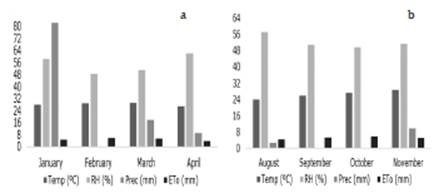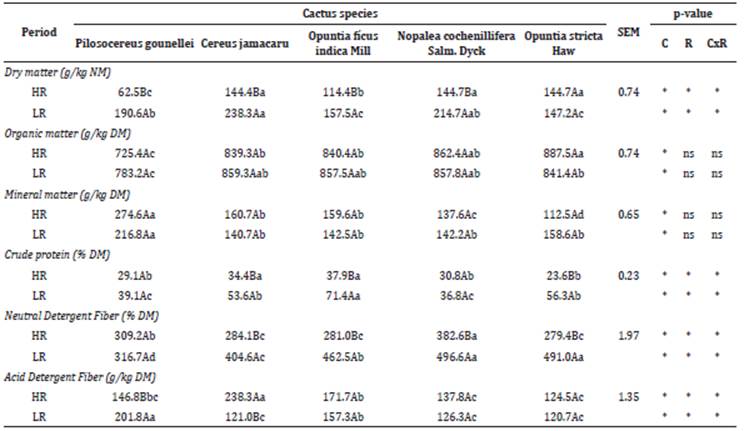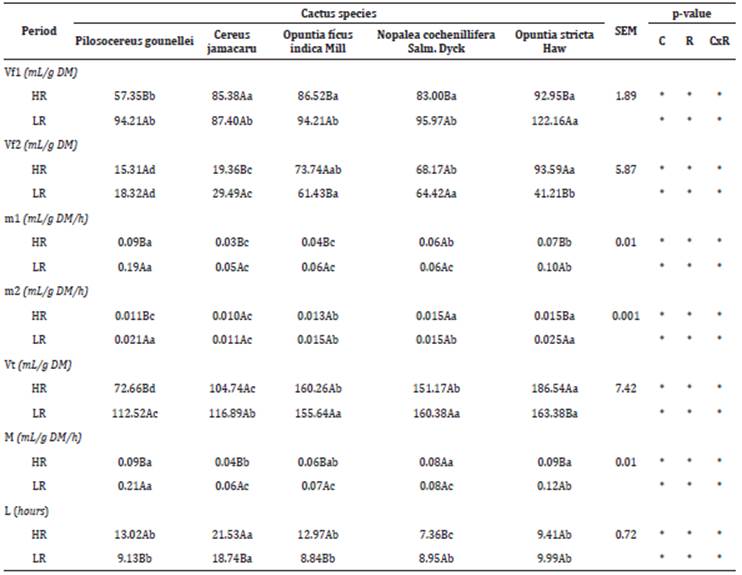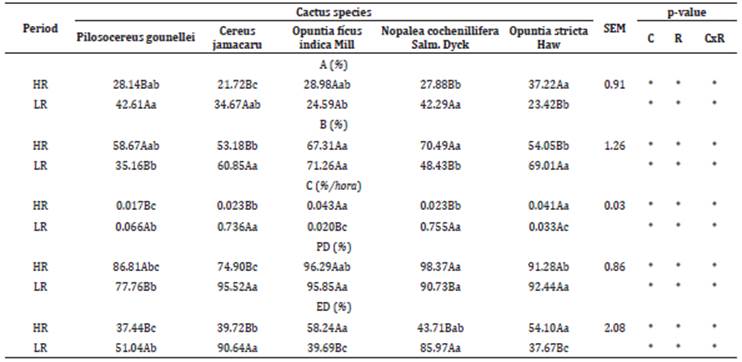INTRODUCTION
Rainfall is one of the most important drivers of ecosystem dynamics and productivity. In this context, arid and semiarid regions in the world are characterized by a variation in rainfall pulses, which are concentrated in only a few months of the year 1.
Considering the local soil and climate conditions, it can be said that the forage production in dry land regions is challenging 2. The lack of rain limits the growth of native and cultivated species, such as grasses and legumes of great water demand, causing a decrease in the biomass and the carrying capacity of pastures 3. Thus, cacti have been frequently used as one of the main forage supports for ruminants during the period of food shortage 4.
Native cacti from arid and semiarid regions such as Xique-xique (Pilosocereus gounellei (Weber ex K. Schum). Bly ex Rowl), Mandacaru (Cereus jamacaru DC.), cactus pear "Gigante" (Opuntia fícus indica MUI), cactus pear "Miúda" (Nopalea cochenillifera Salm. Dyck) and cactus pear "Mexican Elephant Ear" (Opuntia stricta (Haw.) Haw) have high productive potential in environments with low and erratic rainfall 3,4. This is due to the characteristics that these cacti have, such as physiological adaptability to soil and climate conditions remaining succulent during dry periods, high digestibility of dry matter and high-water content making them an excellent dietary strategy where this nutrient is limited, in addition to being excellent sources of energy for being rich in non-fiber carbohydrates 2.
Although the Caatinga vegetation in Brazilian semiarid is driven by low rainfall with low productivity and reduced biomass, it shows large spatial and temporal variations 5. Thus, studies on the nutritional value and in vitro degradation kinetics of cacti in periods of low and high rainfall, are necessary and, to the best of our knowledge, studies comparing exclusively the cacti found in the semiarid regions are scarce 2, being evaluated as part of the ingredients of the diet, compromising the results of its real nutritional value.
The objective of this study was to evaluate the effect of rainfall variability on the chemical composition, in vitro degradability and the gas production of cacti in Semiarid region.
MATERIAL AND METHODS
Experimental site. The experiment was carried out at the premises of the Laboratory of Animal Requirement and Metabolism (LEMA), belonging to the Federal University of the São Francisco Valley (UNIVASF), Petrolina, state of Pernambuco, Brazil (9°24'38" South latitude, 40°29'56" West longitude, 377 m altitude).
The climate is hot semiarid, with rainy season (BSh), concentrated between November and April, with an average annual rainfall of 501.5 mm, irregularly distributed, average annual temperature of 26°C and average annual relative humidity of 60%.
Experimental design, samples and rainfall. This was a completely randomized experimental design in a factorial arrangement of 2 rainfall periods x 5 cactus species, with 5 replications. Samples were collected at different sites in the Caatinga experimental area, belonging to the Brazilian Agricultural Research Corporation (Embrapa Semiarid), in Petrolina, state of Pernambuco, Brazil. The collection area is maintained without irrigation and the soil is classified as plinic yellow Argisol 6.
The cactus species collected were Pilosocereus gounellei (Weber ex K. Schum). Bly ex Rowl (Common name: Xique-xique), Cereus jamacaru DC. (Common name: Mandacaru), Opuntia fícus indica MiII (Common name: cactus pear "Gigante"), Nopalea cochenillifera Salm. Dyck (Common name: Cactus pear "Miúda") and Opuntia stricta (Haw.) Haw (Common name: cactus pear "Mexican Elephant Ear"), all fresh. All cacti had 3 years of establishment in the field.
Collections were carried out in two periods: period with low rainfall (LR), between August and November, with total and average rainfall of 50.6 mm and 12.6 mm/month, respectively; and period with high rainfall (HR), between January and April, with total and average rainfall of 112.0 mm and 28.0 mm/month (Figure 1), respectively. Samplings were carried out in the last month of each experimental period, with analysis of 5 plants of each species of cactus.

Figure 1 Monthly agrometeorological data for periods of high rainfall (a) and low rainfall (b) during the experimental period (Temp Temperature; RH - Relative Humidity; Prec - Precipitation; ETo - Reference evapotranspiration).
Sample preparation. Considering animal consumption, spines of P. gounellei (Weber ex K. Schum). Bly ex Rowl and C. jamacaru DC. were removed by burning with a flamethrower. For the varieties of cactus pear (Opuntia and Nopalea), the secondary and tertiary cladodes of the plants were used 2. Samples were ground in a stationary shredder (PP-35, Pinheiro, Itapira - SP) to an average particle size of approximately 5.0 cm. After this procedure, samples were pre-dried in a forced ventilation oven at 55°C for 72-h and ground into 1 mm and 3 mm particles in a knife mill (Wiley, Marconi, MA 580, Piracicaba, Brazil) to determine the chemical composition, gas production and the in vitro degradability test.
Chemical analysis. Analyses were performed using the methods described by AOAC 7 to determine the content of dry matter (DM; method 967.03), mineral matter (MM; method 942.05), crude protein (CP; method 981.10) and acid detergent fiber (ADF; method 973.18). The neutral detergent fiber (NDF) content was determined using the methodology described by Van Soest et al 8. Hemicellulose (HEM) was determined by the difference between NDF and ADF.
In vitro gas production. In vitro gas production was conducted according technique adapted by Menezes et al 9. The pressure (P; in psi) was measured by a portable pressure transducer (GE Druck Series DPI 705) and readings were taken at 2, 4, 6, 8, 9, 11, 12, 14, 17, 20, 24, 28, 34, 48, 72, 96 and 120-h after incubation. Pressure data were converted to gas volume (1 psi = 4.859 mL gas).
Cumulative gas production data were analyzed by the Gompertz two-compartmental model 10:
V(t) = Vf1/[1 + e(2 - 4m1(L - T))] + Vf2/[1 + e(2 - 4m2(L - T))]
where: V(t) = total maximum volume of gas produced; Vf1 = maximum volume of gas for the fast digesting fraction (non-fiber carbohydrates; NFC); Vf2 = maximum volume of gas for the slow digesting fraction (fibrous carbohydrates; FC); m1 = specific growth rate for the rapid degradation fraction; m2 = specific growth rate for the slow degradation fraction; L = duration of initial digestion events (latency phase), common to both phases, and; T = fermentation time.
In vitro dry matter degradability. The in vitro dry matter degradability (IVDMD) was estimated from the insertion of nylon bags (20mg/cm2 weight and 50 microns of porosity) containing 600 mg sample in flasks with 60 mL buffer solution (combination of solutions A + B with pH 6.8) and 15 mL inoculum collected from 2 fistulated Santa Inês sheep, kept on a diet consisting of elephant grass (Pennisetum purpureum), concentrate based on corn and soybean, in addition to mineral salt (Ovinofós, Tortura, Porto Alegre, Brazil). The rumen content was filtered through gauze, constantly injecting CO2 to maintain the anaerobic environment and stored at 39°C. Samples were incubated at times 0, 2, 6, 12, 24, 48, 96 and 120-h. After in vitro fermentation, bags were washed and dried in an oven at 105°C for 4-h, and weighed. Samples at time 0 were just washed with distilled water at 39°C for 5 min, and then dried and weighed 11.
To determine potential degradability (PD), the 0rskov and McDonald 12 model was used:
PD = a + b (1 -e-ct)
where: a = water-soluble fraction; b = water-insoluble fraction, but potentially degradable; c = degradation rate of the fraction "b"; and t = incubation time in hours. The letter "e" is the natural log of "-ct".
The effective degradability (ED) was calculated using the formula:
ED = a + (b x c) / (c + k)
where: k is the rate of passage. The gas production rate obtained by the semi-automated gas production technique (m1+m2) was used to estimate the rate of passage (k) used in the degradability test.
Statistical analysis. Data were initially analyzed using the UNIVARIATE procedure to check the normal distribution of the data. After observing normal distribution, analysis of variance was applied, using the PROC ANOVA command from the Statistical Analysis System (SAS, version 9.1). Parameters of the gas production and degradability model were estimated by the nonlinear regression procedure (NLIN) of SAS (version 9.1). The following statistical model was adopted:
Yijk = m + ai + Pj + ap ij + eijk
where Y is the observed value of the variable ijk that refers to the k-th repetition of the combination of the i-th level of factor A with the j-th level of factor B; |i is the mean of all experimental units of the variable; ai is the cactus species effect on the observed value Yij; Pj is the rainfall periods effects on the observed value Yijk; apij is the interaction effect between cactus species and rainfall periods; and eijk is the error associated with Yijk's observation. Tukey's test was applied to compare the means, with probability values below 5% (p<0.05) being considered significant.
RESULTS
There was an interaction effect of rainfall variation and cactus species for DM, CP, NDF and ADF (p<0.05; Table 1). Isolated effect was observed for the OM content, in which P. gounellei presented the lowest levels for this variable, in relation to the other studied species (p<0.05; Table 1). There was an isolated effect for the MM content, in which P. gounellei showed the highest levels for this variable, in relation to the other studied cacti (p<0.05; Table 1).
Table 1 Chemical composition of cactus species collected in high rainfall (HR) and low rainfall (LR) periods in the Brazilian semiarid (n=5).

DM: Dry matter; C: Cactus species effect; R: Rainfall periods effects: C x P: interaction effect between cactus species and rainfall periods; SEM: Standard error of the mean; Capital letters in the column indicate the statistical effect of rainfall periods on cactus species; Lower case letters on the line indicate statistical effect on cactus species within rainfall periods; Significant at the 5% level by the Tukey test; * p<0.05; ns: Not significant.
There was an interaction effect of rainfall variation and cactus species for in vitro gas production (p<0.05; Table 2). The period of low rainfall provided a greater cumulative production of gases, in which O. stricta Haw showed a higher production of gases from non-fiber carbohydrates (Vf1 = 122.16 mL/g DM) among the other evaluated cacti.
The reduction in gas production from non-fiber carbohydrates during the period of high rainfall was more evident for P. gounellei, which showed a reduction of 36.86 mL/g DM during the transition between the low and high periods of rainfall (Table 2).
Table 2 In vitro gas production from cactus species collected in high rainfall (HR) and low rainfall (LR) periods in the Brazilian semiarid (n=5).

Vf1: Maximum gas production potential of non-fibrous carbohydrates; Vf2: Maximum gas production potential of fibrous carbohydrates; m1: rate of non-fibrous carbohydrate gas production; m2: rate of production of fibrous carbohydrate gases; Vt: maximum gas production potential of total carbohydrates; M: total gas production rate; L: duration of initial digestion events (latency phase), common to both phases; DM: Dry matter; C: Cactus species effect; R: Rainfall periods effects: C x P: interaction effect between cactus species and rainfall periods; SEM: Standard error of the mean; Capital letters in the column indicate the statistical effect of rainfall periods on cactus species; Lower case letters on the line indicate statistical effect on cactus species within rainfall periods; Significant at the 5% level by the Tukey test; * p<0.05; ns: Not significant.
With respect to the rainfall periods and the studied cacti, P. gounellei presented the lowest values for gas production from the fiber fraction (Vf2; 15.31 mL/g DM in high rainfall and 18.32 mL/g DM in low rainfall) and the highest values for the rates of gas production from the fiber fraction (m1; 0.09 mL/g DM/h in high rainfall and 0.19 mL/g DM in low rainfall) (p<0.05; Table 2).
The varieties N. cochenillifera and O. stricta Haw in the period of high rainfall showed the highest gas production rates of the non-fiber fraction (m2), with average value of 0.015 mL/g DM/h, respectively, for the two cacti (p<0.05; Table 2).
O. stricta Haw in the period of high rainfall showed a higher value for the potential of total gas production (186.54 mL/g DM) in relation to the other cacti. P. gounellei, on the other hand, showed a reduction in the total gas production with increasing rainfall (72.66 mL/g DM; Table 2).
The latency phase (L) during the high rainfall period was reduced in N. cochenillifera. Regarding the period of low rainfall and cacti, C. jamacaru had a longer colonization time (p<0.05; Table 2).
There was an interaction effect of rainfall variation and cactus species for in vitro dry matter degradability (P<0.05; Table 3). O. fícus indica Mill and O. stricta Haw reduced the water-soluble fraction (a) and the degradation rate of fraction B (C; %/hour) during the transition from high to low rainfall (p<0.05; Table 3).
Table 3 In vitro degradability from cactus species collected in high rainfall (HR) and low rainfall (LR) periods in the Brazilian semiarid (n=5).

A: Water-soluble fraction; B: fraction insoluble in water, but potentially degradable; C: degradation rate of fraction "B"; PD: potential degradability; ED: effective degradability; C: Cactus species effect; R: Rainfall periods effects: C x P: interaction effect between cactus species and rainfall periods; SEM: Standard error of the mean; Capital letters in the column indicate the statistical effect of rainfall periods on cactus species; Lower case letters on the line indicate statistical effect on cactus species within rainfall periods; Significant at the 5% level by the Tukey test; * p<0.05; ns: Not significant.
P. gounellei and N. cochenillifera reduced the fraction insoluble in water, but potentially degradable (b) in relation to the other cacti, during the period of high rainfall (p<0.05; Table 3).
DISCUSSION
Cacti are of great importance for dry land regions mainly in periods of low or zero rainfall, becoming a source of water and one of the main forages to feed herds, as they adapt to the soil and climate conditions of the region, have the capacity to store water in its structure and be persistent to drought 13. This adaptation is because these plants are classified as plants with the Crassulacean Acid Metabolism (MAC), a mechanism that gives them high efficiency in the use of water 14. This efficiency was verified in the present study, where, with the exception of Opuntia stricta Haw, which remained stable in the two periods evaluated, the other studied cacti increased their moisture content with the highest water supply received.
Protein and fiber contents are directly related to climatic factors, season, water availability, plant age, part of the plant collected and handling of the plant during sample preparation 2. The high rainfall, in addition to providing a reduction in the content of DM in the cacti, also promoted a reduction in the content of CP and NDF. According to Matias et al 15, cacti have low content of DM, CP and NDF and when supplied as exclusive food to ruminants, they can cause metabolic disturbances in animals, with a consequent drop in performance, and it is recommended to combine them with other rich foods in highly effective fiber and protein, so they can meet the nutritional needs of species and animal categories 16.
Since, for the growth and development of ruminal microorganisms responsible for the degradation of nutrients from the fiber fraction of the forage, the diet selected by the animal should contain values equal to or greater than 7 g/kg DM crude protein 17. Thus, only O. ficus indica Mill during the period of low rainfall, had a CP content considered sufficient to meet the minimum requirements for the development of rumen microorganisms (Table 1). Diets with low nitrogen availability can reduce fiber digestion and thus reduce intake due to the slow passage of food through the rumen 18.
Regarding the ADF content, P. gounellei, among the other cacti, presented higher contents of this nutrient during the period of low rainfall. The opposite was found for C. jamacaru, whose ADF content was higher in the period of high rainfall, compared to the other cacti. ADF values obtained for these cacti are lower than those presented by Carvalho et al 4, who reported values of 28.10% DM and 32.47% DM of ADF for P. gounellei and C. jamacaru, respectively. These variations in fiber concentrations of the studied species affirm the active participation of the semiarid climate in the caatinga of northeastern Brazil, offering unique features to the different species of cacti in the region 19.
Despite the higher ADF content for P. gounellei and C. jamacaru, all cacti studied showed low contents of this component and this is explained by the amount of carbohydrates, especially non-fiber carbohydrates (sugar, starch, organic acids and fructose) present in these plants, which are an important source of energy for ruminants that use them for the development of the microorganisms that colonize the rumen 20.
The increase in the MM content for P. gounellei in relation to the other cacti can be explained by the reduction in organic matter, since these variables are inversely proportional. According to Furtado et al 21, cacti usually have a high content of mineral matter in their composition, with P. gounellei standing out among cacti because they have higher levels of MM, a fact that corroborates our findings.
Gas production is an important indicator of the degradability and energy density of food, varying due to the concentration of fibers, proteins and the content of tannins 22. The non-fiber fraction of carbohydrates in this cactacea is probably more readily available for ruminal fermentation during the low rainfall period due to a possible adaptation strategy of this cactus for the next rainy season, which will use their reserves to increase its production capacity 23.
The results observed for gas production of P. gounellei are possibly associated with the fiber content of carbohydrates of this cactus, which is related to the degradation rate and colonization time by ruminal microorganisms 24.
It is known that in vitro gas production results almost entirely from the carbohydrates present in the incubated material and indicates degradation by ruminal microorganisms 25. Thus, the higher gas production rates of the non-fibrous fraction (m2) obtained by the varieties N. cochenillifera and O. stricta Haw in the period of high rainfall are correlated with the low content of acid detergent fiber that these cacti presented in relation to others during the analyzed period, justifying the observed results.
The reduction in total gas production with the increase in precipitation presented by P. gounellei can be explained by its anatomical and physiological characteristics, whose stems and branches are divided into vascular cylinder and central stem, with the highest percentages of soluble carbohydrates in the central stem 26. Thus, probably, during a period of low rainfall there was a thickening of this structure and accumulation of soluble carbohydrates to help plant metabolism during the period of water scarcity.
The short colonization time by ruminal microorganisms (latency phase) observed for N. cochenillifera during the period of high rainfall is due to its physical and chemical characteristics, as the soluble fraction is an energetic substrate for microorganisms and has rapid fermentation, which facilitates the processes of adhesion and colonization in the substrate. This can increase the fermentation of fibrous carbohydrates and shorten the latency period 27. Regarding the period of little rain and cacti, C. jamacaru had a longer colonization time, which is not good, as the microorganisms will adhere to the particles more slowly. The higher latency phase, the slower the fiber degradation 28.
Some cacti, in the presence of rain, increase their metabolizable nutritional fractions for growth and multiplication of cladodes and, thus, increase the area of the cladodes, mainly to increase photosynthetic capacity 29. This was observed in the present study by the reduction of the water-insoluble but potentially degradable fraction (b) presented by the cacti P. gounellei and N. cochenillifera.
With the exception of C. jamacaru, during the high rainfall period and P. gounellei, in the low rainfall period, the studied cacti obtained a potential degradability of over 80%, regardless of the rainfall periods analyzed, suggesting a high proportion of digestible and fermentable nutrients in these cacti.
The transition from the low-rainfall to the high-rainfall period resulted in a decline in the effective degradability of all studied cacti. Only O. ficus indica Mill and O. stricta Haw during the period of high rainfall presented degradability above 50%, which is satisfactory. This degradability is a reflection of the high rate of degradation of fraction B, which in these cacti was higher than the others during the period of high rainfall, making higher percentages of plants more readily available for ruminal fermentation 30.
The chemical composition, the coefficients of gas production and the degradability of the cacti were influenced by the species of cacti and the rainfall variation. Varieties of cactus pear (Opuntia and Nopalea) stood out among the cacti tested in relation to gas production and in vitro degradability.















